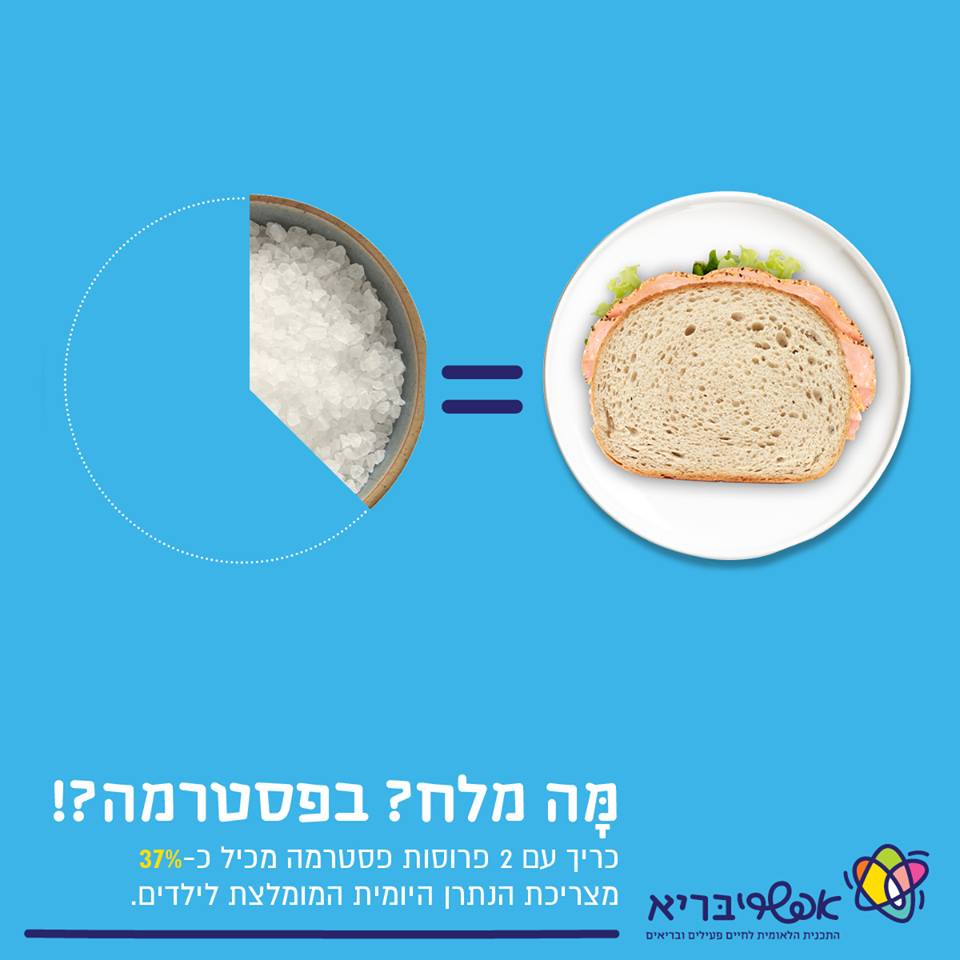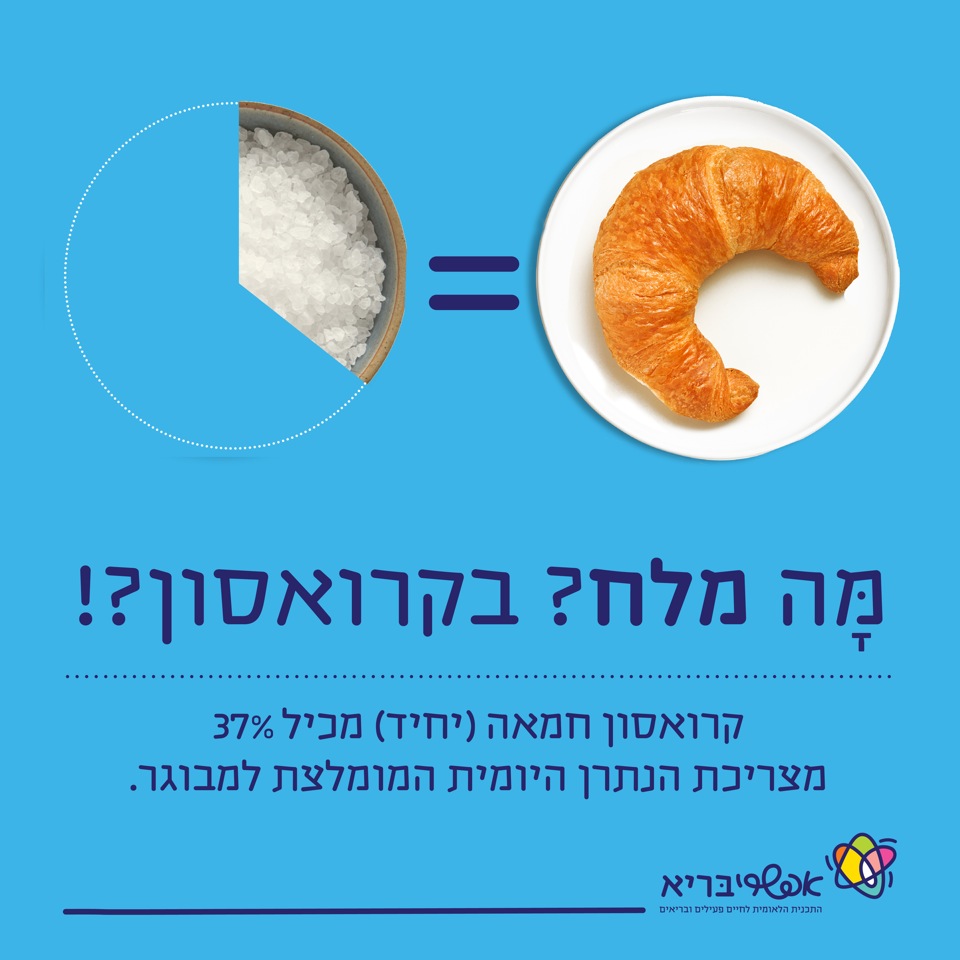
Salt x 2
Our average daily intake of salt is 9.6 grams, which makes two teaspoons. This quantity is twice the recommended daily intake of salt in a healthy diet.
Why are we drawn to the flavor of salt?
“Regular” table salt that we all know consists of mainly two minerals: sodium and chloride. (If you studied chemistry you might recall the formula NaCl). Sodium and chloride found in salt are essential for the functioning of the heart, kidneys, muscles and nerve conduction. Since the human body is unable to produce these minerals, it relies on absorbing them from the food we eat – which is why the taste of salt attracts us.
It is important to know that the levels of salt we are used to are an acquired taste. The saltier the food we get used to eating, the more salt we’ll want to consume.
But like many other substances – different amounts have a different effect and what benefits the body in certain quantities – might cause damage in bigger quantities. Excessive sodium intake is linked to a long list of cases of many chronic diseases and even some cancers, which can be fatal.
How much salt is recommended?
The Ministry of Health's Nutrition Division defined the maximum recommended daily intake of salt (which can be measured in grams or teaspoons) and sodium (measured in milligrams, and also indicated on the nutritional value tables on food products):
|
Age |
Grams of salt |
Equivalent in teaspoons |
Quantity of sodium, milligrams |
|---|---|---|---|
|
Adults |
5-6 |
1 teaspoon |
Approx. 2,000-2,400 |
|
9-13 |
5.5 |
1 teaspoon |
Approx. 2,200 |
|
4-8 |
No more than 4.8 |
Less than 1 teaspoon |
Approx. 1,900 |
|
1-3 |
No more than 3.8 |
A little over ½ teaspoon |
Approx. 1,500 |
|
Under 12 months |
It is recommended not to add salt at all. |
|
|
How much salt do we actually consume?
A lot... too much. According to the Ministry of Health, the average daily salt intake of adults in Israel is 9 grams, and of adolescents about 12 grams of salt per day – twice as much as the recommended maximum daily salt intake.
What is the source of the sodium we consume?
It is important to understand that a reduction of the quantities of sodium is not related to reducing salt from saltshakers. The daily sodium intake from this source is a total of 13%, while the raw foods we consume like vegetables contribute only 12% of our daily intake.
Where is the salt we consume hiding?
75% is hiding in processed foods. 15% from the saltshaker. 10% from natural sources.

75% (!) of our daily sodium intake comes from processed foods such as ready-made salads, cheeses, sausages, sauces and more. This is because beyond enhancing flavor, sodium is also used by the food industry to preserve food, control bacteria, mask aftertastes and for other purposes.
How much salt is hiding in food products? Here are a few examples:

So much salt! In soy sauce?!
In 50 ml (approx. a ¼ cup) of soy sauce there is around 2,500 mg of sodium, equivalent to the daily intake recommended for an adult.

Salt?! In pastrami?!
A sandwich with two slices of pastrami contains about 37% of the recommended daily sodium intake for children.
A sandwich made of two slices of white bread and two normal-size slices of pastrami contains 750 mg sodium (350 mg in the bread and 400 mg in the pastrami), which equals 39% of the recommended daily sodium intake for children aged 4-8!

Salt?! In a croissant?!
A single butter croissant contains 37% of the daily sodium intake recommended for an adult.
Did you treat yourselves in the morning with a big butter croissant? Enjoy! You just consumed 37% of the daily recommended sodium intake for an adult.
How can we reduce quantities? Gradually!
Our taste buds are used to high levels of salt due to years of consuming processed foods. A sudden sharp reduction will make our food taste bland and tasteless, so the key is to reduce intake gradually. It is recommended to switch to home cooking instead of consuming processed foods – this way we can control the salt intake. Use fresh or dried herbs and pure spices instead of pre-prepared soup powders. The taste will be richer and contain less salt. A combination of onions and garlic in stews and salads will also add a greater range of flavors to food.
It's important to remember that salt is largely an acquired taste: a gradual reduction in salt in home cooking along with a reduced exposure to processed foods, powders and savory snacks, retrains our taste buds and our children’s taste buds to “make do” with less salt and to notice other flavors. It is important to avoid excessive intake of sodium from an early age – in fact, from birth. You should talk to your children about the problems of excessive salt intake, get them to help you check nutrition labels and cook with them to turn the process into fun.
Processed sauces and foods? It is recommended to reduce quantities and before buying – check, compare and make healthier choices. In many cases, products of the same category contain different levels of sodium, so you can choose the product that contains the least sodium.
Man shall not live on bread alone – how to choose the right bread
Bread? The many varieties can be confusing, so the Ministry of Health and EfshariBari’s “Food Label” was launched in 2014 as part of the national project to ensure the bread you buy satisfies the following requirements:
- At least 80% of flours are whole grain
- Up to 250 calories per 100 gram product
- Up to 400 mg sodium per 100 gram product
Further reading
Sodium at the Ministry of Health’s Nutrition Division (Hebrew)
How to reduce sodium intake – Ministry of Health (Hebrew)



